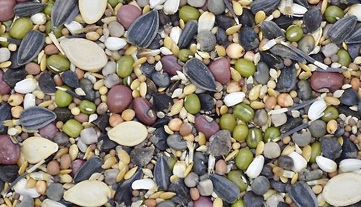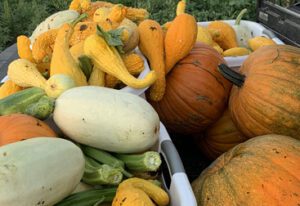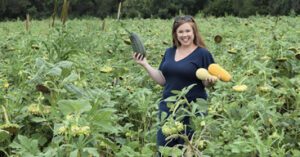
The MILPA farming technique originated in Central America where the Mayans used a mixture of corn, squash, and beans to improve the soil and grow food. At Green Cover we went beyond the three sisters and compiled a mix of over 40 different seeds. This is an excellent way to utilize a small portion of land to produce food without going through the hassle of tillage, weeding, and hours of planning. It is also a great way to rekindle the feeling of pride and satisfaction that comes from producing healthy food that is being directly consumed by family, friends and neighbors.
The modern Milpa concept was launched in 2017 with a partnership between Green Cover and the Farm to Food Bank in Oklahoma. Green Cover donated Milpa garden seed to several regenerative farmers throughout Oklahoma who partnered with the Regional Food Bank of Oklahoma. The simplistic beauty of the system is that all the seeds were mixed together and drilled with a regular grain drill, turning a small field into a large garden with very low labor inputs. Green Cover provided the seed mixes which included fresh greens (turnips, collards, mustard), root vegetables (radish, turnips), legumes (cowpeas, mung beans, black beans), and vine crops (squash, melons, cucumbers, pumpkins). The gleaning efforts were a true community effort with members from various community groups all pitching in to help feed their community. In 2017, about 6,800 pounds (about 5,440 meals) of fresh, healthy fruits and vegetables were donated from these gardens to the Regional Food Bank of Oklahoma. The Milpa gardens not only provided fresh and healthy food to these local communities but helped build local relationships as well. These gardens also served as a diverse cover crop mix to help improve soil health, water quality, and habitat for pollinators and wildlife on these farms.
Ryan and Jennifer Speer of Sedgwick, KS are Milpa garden veterans having grown tons of produce each of the last few years for their local community. “A typical garden is fairly high maintenance but the Milpa garden is plant it and forget it,” notes Ryan.

Photo By: Ryan Speer
“Since there are no neat, straight rows, harvesting is hard work. “It’s kind of like a scavenger hunt. The yellow squash and pumpkins show up really nice but the green cucumbers are really hard to see in there. When the Milpa really starts to produce, we’ll start getting 2-5 laundry baskets of vegetables every other day.”
First Acre Program
At Green Cover, we believe that with healthy soils we can grow healthy plants, which will produce healthy food, which will build healthy people, families, and communities. With that in mind, we have partnered with The Nature Conservancy and Syngenta to accelerate our Milpa First Acre Program. This program was started in 2018 to donate an acre of highly diverse Milpa garden seed to anyone who is working with their local food banks or resource centers to help feed and build their local community! The program has slowly grown but with the support of our partners, we will have enough seed to quadruple what we have been doing and we will be able to enroll more than 1,000 First Acre participants and provide them with free seed! So for the benefit of your community, consider adding a little bit of Milpa to your already chaotic life and forge partnerships with your community to bring this vision to fruition! If you are not a farmer but are interested in the program, consider spearheading an effort to connect local farmers and local civic or church groups to grow fresh, healthy produce for your community. For more information or to sign up for the Milpa First Acre Program, go to www.milpagarden.com.

Photo By: Lisa Knouf
This article first appeared in the 8th Edition of Green Cover's Soil Health Resource Guide.
Also check out the 10th edition, our latest Soil Health Resource Guide, over 90 pages packed with scientific articles and fascinating stories from soil health experts, researchers, farmers, innovators, and more! All as our complimentary gift to you, a fellow soil health enthusiast!